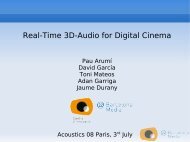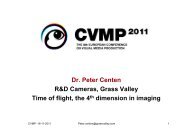EBU tech-i edition 8 - EBU Technical
EBU tech-i edition 8 - EBU Technical
EBU tech-i edition 8 - EBU Technical
Create successful ePaper yourself
Turn your PDF publications into a flip-book with our unique Google optimized e-Paper software.
industry news<br />
Radio Activity<br />
<strong>EBU</strong> <strong>Technical</strong>’s Mathias Coinchon reports on The Digital<br />
Radio Week hosted earlier this year at the <strong>EBU</strong>.<br />
The <strong>EBU</strong> Digital Radio Week 2011<br />
took place from February 14th to<br />
February 17th. It was the second event in<br />
a week’s gathering and meetings of radio<br />
organisations working on the standardisation<br />
and promotion of Digital Radio in the wider<br />
sense. Taking part were: Digital Radio<br />
Mondiale, IMDA, RadioDNS and WorldDMB.<br />
These four organisations are grouped in<br />
the European Digital Radio Forum (EDRF),<br />
a platform created last year by the <strong>EBU</strong> to<br />
enable discussion, exchange and possible<br />
common actions.<br />
Workshops<br />
This year there was also two ’hands on’<br />
<strong>tech</strong>nical workshops aimed at engineers<br />
and developers. The first was the Open<br />
Software Defined Radio Workshop with<br />
the Communication Research Center<br />
Canada (CRC) where participants were<br />
able to learn how to set up their own DAB/<br />
DAB+ transmission using free, open tools<br />
developed by CRC.<br />
The second workshop was on RadioDNS<br />
to help participants learn how to use free<br />
openly available RadioDNS tools to produce<br />
basic hybrid radio applications. Using the<br />
<strong>EBU</strong> <strong>Technical</strong> RadioDNS/RadioVIS server,<br />
three <strong>EBU</strong> Member broadcasters were able<br />
to create a basic visualisation service for their<br />
stations. This experimental service created<br />
by the <strong>EBU</strong> <strong>Technical</strong> lab is intended to offer<br />
a boot solution for broadcasters and to break<br />
the chicken-and-egg situation between<br />
receiver manufacturers and broadcasters<br />
by having more broadcasters ready with the<br />
system.<br />
Organisations’ Meetings<br />
Apart from the two workshops, meetings<br />
took place involving the following organisations:<br />
the DRM <strong>Technical</strong> Committee, where the<br />
group worked on the new DRM+ standard;<br />
RadioDNS 2nd General Assembly<br />
(RadioDNS is just one year old) where<br />
the new Steering Board was elected; The<br />
WorldDMB <strong>Technical</strong> Committee where<br />
members decided, among other things, to<br />
create a new task force to produce<br />
best practices for digital radio services.<br />
These were followed by IMDA <strong>Technical</strong><br />
Committee, task forces and Steering Board<br />
meetings.<br />
EDRF: European Digital Radio<br />
Forum<br />
The presidents and other representatives<br />
from the four organisations of the EDRF met<br />
to discuss further actions. In particular, it<br />
was decided to soft lobby at the European<br />
level to promote radio’s future, and to ensure<br />
that radio as a media is considered in the<br />
agenda of administrations. In this regard, the<br />
first meeting with Philippe Lefebvre from the<br />
European Commission took place.<br />
The Radio Summit<br />
In the middle of the week, the Radio<br />
Summit was open to all with presentations 1<br />
being made on digital radio business cases,<br />
<strong>tech</strong>nical developments and updates as well<br />
as news on the deployment status of the<br />
different digital radio systems.<br />
Conclusion<br />
In 2011, one cannot say anymore that the<br />
future of radio is with one particular system,<br />
neither broadcast only or broadband only.<br />
The future is hybrid/multiplatform and we<br />
must seek convergence. Each platform has<br />
its own strengths depending on the context<br />
and it is the task of each organisation to<br />
promote their systems and make them<br />
happen in the market. However, each can<br />
act in a coordinated way to secure a future<br />
for radio beyond analogue by creating<br />
new experiences, exchanging practices,<br />
developing tools, products, doing promotion<br />
and putting it in the agenda of each country’s<br />
administration. The Radio Week is an event<br />
made to help us reach these objectives and<br />
promote exchanges. Make it happen and<br />
see you next year.<br />
Participants from Teleko (Czech Republic)<br />
producing an L band DAB transmission<br />
using CRC mmbTools on their laptop and a<br />
Universal Software Radio Peripheral (USRP<br />
black box at the front).<br />
FM+RadioVIS service running on the Nokia<br />
N900 mobile phone with RSR Couleur3<br />
programme.<br />
European Digital Radio Forum meeting<br />
Digital Radio Summit 2011<br />
1<br />
All presentations and recordings can be found on: http://<strong>tech</strong>.ebu.ch/events/digitalradio11<br />
10 <strong>tech</strong>-i | http://<strong>tech</strong>.ebu.ch | june 2011





